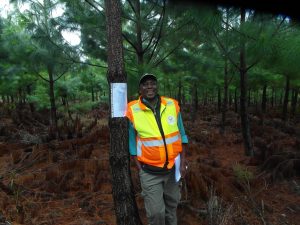Pine Hybrid Project
In 2001, Camcore members embarked on a long-term Pine Hybrid Project. The goal of the project was to produce an array of new pine hybrid combinations and begin to investigate their commercial utility. To make the project logistically feasible, each member was assigned a small number of hybrid combinations to produce, and each hybrid was to be represented by a bulk mix of polymix families (typically four to five females crossed with a pollen mix from eight to ten males).
To date, Camcore members have produced 23 verified pine hybrid crosses and established 82 trials in 8 countries: Argentina, Brazil, Colombia, Kenya, Mozambique, Uruguay, South Africa and Tanzania. A number of companies served as Regional Coordinators, which involved receiving the hybrid seeds, producing rooted cuttings from hedges, and distributing the hybrid plants to the different member companies within the country. Three series of different hybrid seeds have been shipped to the members, the first in 2005, the second in 2007, and the third in 2011. Some of the trials established in these countries have been measured at 3 and 5 years of age.

Throughout much of South Africa where P. patula is planted commercially, the growth of the P. patula x P. tecunumanii hybrid, particularly with the low elevation (LE) P. tecunumanii, is much greater than P. patula. Other hybrids with commercial potential under similar environmental conditions are P. caribaea x P. tecunumanii LE, P. patula x P. oocarpa, P. elliottii x P. caribaea, P. tecunumanii HE x P. oocarpa, and P. patula x P. tecunumanii HE.
In parts of South Africa at low elevations, where P. elliottii is the commercial species, a number of hybrids appear to offer superior growth. For example, in one trial in the southern Cape region, P. elliottii x P. caribaea, P. patula x P. tecunumanii, P. patula x P. oocarpa, P. tecunumanii x P. caribaea, and P. tecunumanii x P. oocarpa all have better volume than the improved P. elliottii controls.
At five years, the hybrids from the first series with the best potential in Argentina and Brazil are P. elliotii x P. caribaea, and P. caribaea x P. tecunumanii low elevation. At three years, the most promising hybrid in the second series is P. greggii var. australis x P. tecunumanii high elevation (HE). All of these hybrids are growing much faster than the P. taeda controls, the commercial species planted in the region.
As a result of these trials, in 2012, Camcore members in southern Africa began a breeding program for P. patula x P. tecunumanii, with a goal of producing approximately 300 full-sib families. The idea is to identify the best hybrid families for commercial plantations, analagous to selecting the best families in pure species breeding. Similarly, in 2016, Camcore members in Latin America began a breeding program for P. tecunumanii x P. greggii var. australis with a goal of producing approximately 300 full-sib families.
Eucalypt Hybrid Project
In 2011, a group of Camcore members agreed to participate in a cooperative Eucalypt Hybrid Breeding Project. The objectives of this project were to create full-sib families of a wide array of eucalypt hybrids and assess their potential in different environments.
When this project began, Camcore had a strong genetic base for Eucalyptus urophylla, but we had just begun to expand our genetic base with other Eucalyptus species. For this reason, participants in the project used their proprietary genetic material as hybrid parents, and different crosses were assigned to members based on availability of parents. The idea was to produce hybrids with potential in any geographic region or climate, and the goal was to produce 20 full-sib families of each hybrid. We believe that this will be sufficient to test the commercial potential of the hybrid, explore the patterns of genetic variation, and provide a genetic base for the selection of progeny or clones from hybrids that demonstrated commercial potential.
By the end of 2015, hybrid seeds for the following crosses were successfully produced, collected and distributed: E. grandis x E. pellita, E. grandis x E. benthamii, E. grandis x E. brassiana, E. grandis x E. dunnii, E. grandis x E. globulus, E. grandis x E. nitens, E. grandis x E. smithii, E. urophylla x E. brassiana and E. urophylla x E. pellita. This project demonstrates a major benefit of Camcore’s cooperative work: sharing the cost, workload, and results.
As of 2015, Camcore has built a substantial genetic resource of eucalypt species. These new eucalypt genetic resources have been distributed widely among all Camcore members, putting us as a group in a very strong position to move forward. We are excited about a future Phase 2 of the Eucalypt Hybrid project.

